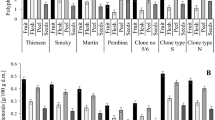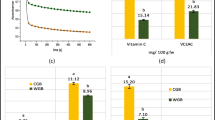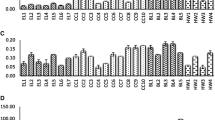Abstract
Total antioxidant activity of six non-cultivated but traditionally collected fruits from the south of Europe was assessed by measuring their ability to reduce the hydroxyl radical \( \left( {{\hbox{O}}{{\hbox{H}}^\bullet }} \right) \) and hydrogen peroxide (H2O2), and their Trolox equivalent antioxidant capacity (TEAC). This antioxidant activity was compared with that shown by the synthetic antioxidants BHA (E-320), BHT (E-321) and propyl gallate (E-310). Total phenolics, ascorbic acid and the carotenoid content of the fruits were also analyzed. All fruits showed a high ability to scavenge the \( {\hbox{O}}{{\hbox{H}}^\bullet } \) radical, ranging from 60.61% to 81.04% inhibition for Rosa canina and Crataegus monogyna, respectively. The H2O2 scavenging capacity and the TEAC value varied widely, ranging between 3.63% and 87.26% inhibition of H2O2 and between 0.47 and 416.64 mM trolox g−1 FW for Sorbus domestica and Rosa canina, respectively. The antioxidant activity of fruits was higher than that of the synthetic additives analyzed, except in the TEAC assay. The phenolic and carotenoid content of R. canina was much higher than that of the other fruits analyzed and its ascorbic acid concentration was also high, reflecting its higher efficacy towards \( {\hbox{ABT}}{{\hbox{S}}^{ \bullet - }} \) (TEAC assay) and H2O2 species. In spite of these associations, the correlation coefficients between total antioxidant activity and the antioxidant compounds analyzed were not very significant; only phenolics and carotenoids showed a marginal correlation with the TEAC assay. The results support the possible use of R. canina as natural antioxidant to replace the synthetic additives, as well as their use in the production of functional foods with a high antioxidant activity.
Similar content being viewed by others
References
Rivera D, Verde A, Fajardo J, Inocencio C, Obon C, Heinrich M (2006) Guia etnobotanica de los alimentos locales recolectados en la provincia de Albacete. Instituto de Estudios Albacetenses. Diputación de Albacete, Spain
Goldberg I (1994) Functional foods: designer foods, pharmafoods, nutraceuticals. Aspen Publishers, New York
Šavikin K, Zdunić G, Janković T, Tasić S, Menković N, Stević T, Đorđević B (2009) Phenolic content and radical scavenging capacity of berries and related jams from certificated area in Serbia. Plant Foods Hum Nutr 64:212–217
Barlow SM (1990) In: Hudson BJF (ed) Food Antioxidants. Elsevier Applied Science, London
Koleva II, Van Beek TA, Linssen JPH, De Groot A, Evstatieva LN (2002) Screening of plant extracts for antioxidant activity: a comparative study on three testing methods. Phytochem Anal 13:8–17
Leong LP, Shui G (2002) An investigation of antioxidant capacity of fruits in Singapore markets. Food Chem 76:69–75
Valko M, Izakovic M, Mazur M, Rhodes CJ, Telser J (2004) Role of oxygen radicals in DNA damage and cancer incidence. Mol Cell Biochem 266:37–56
Peschel W, Bohr C, Plescher A (2008) Variability of total flavonoids in Crataegus—factor evaluation for the monitored production of industrial starting material. Fitoterapia 79:6–20
Becker EM, Nissen LR, Skibsted LH (2004) Antioxidant evaluation protocols: food quality or health effects. Eur Food Res Technol 219:561–571
Heim KE, Tagliaferro AR, Bobilya DJ (2002) Flavonoid antioxidants: chemistry, metabolism and structure-activity relationships. J Nutr Biochem 13:572–584
Serrano M, Valverde JM, Guillén F, Castillo S, Martínez-Romero D, Valero D (2006) Use of aloe vera gel coating preserves the functional properties of table grapes. J Agric Food Chem 54:3882–3886
Murcia MA, Egea I, Romojaro F, Parras P, Jimenez AM, Martínez-Tome M (2004) Antioxidant evaluation in dessert spices compared with common food additives. Influence of irradiation procedure. J Agric Food Chem 52:1872–1881
Egea MI, Sanchez-Bel P, Martinez-Madrid MC, Flores FB, Romojaro F (2007) The effect of beta ionization on the antioxidant potential of Búlida apricot and its relationship with quality. Postharvest Biol Technol 46:63–70
Singleton VL, Orthofer R, Lamuela-Raventos RM (1999) Analysis of total phenols and other oxidation substrates and antioxidants by means of Folin-Ciocalteu reagent. Meth Enzymol 299:152–178
Rollet-Labelle E, Grange MJ, Elbim C, Marquetty C, Gougerot-Pocidalo MA, Pasquier C (1998) Hydroxyl radical as a potential intracellular mediator of polymorphonuclear neutrophil apoptosis. Free Radic Biol Med 24:563–572
Moskovitz J, Yim KA, Choke PB (2002) Free radicals and disease. Arch Biochem Biophys 397:354–359
Van den Berg R, Haenen GRMM, Van den Berg H, Bast A (1999) Applicability of an improved Trolox equivalent antioxidant capacity (TEAC) assay for evaluation of antioxidant capacity measurements of mixtures. Food Chem 66:511–517
Gao X, Bjork L, Trajkovski V, Uggla M (2000) Evaluation of antioxidant activities of rosehip ethanol extracts in different test systems. J Sci Food Agric 80:2021–2027
Surveswaran S, Cai YZ, Corke H, Sun M (2007) Systematic evaluation of natural phenolic antioxidants from 133 Indian medicinal plants. Food Chem 102:938–953
García-Alonso M, de Pascual-Teresa S, Santos-Buelga C, Rivas-Gonzalo JC (2004) Evaluation of the antioxidant properties of fruits. Food Chem 8:13–18
Deighton N, Brennan R, Finn C, Davies HV (2000) Antioxidant properties of domesticated and wild Rubus species. J Sci Food Agric 80:1307–1313
Tabart J, Kevers C, Sipel A, Pincemail J, Defraigne JO, Dommes J (2007) Optimisation of extraction of phenolics and antioxidants from black currant leaves and buds and of stability during storage. Food Chem 105:1268–1275
Shan B, Cai YZ, Sun M, Corke H (2005) Antioxidant capacity of 26 spice extracts and characterization of their phenolic constituents. J Agric Food Chem 53:7749–7759
Dall’Acqua S, Cervellati R, Loi MC, Innocenti G (2008) Evaluation of in vitro antioxidant properties of some traditional Sardinian medicinal plants: investigation of the high antioxidant capacity of Rubus ulmifolius. Food Chem 106:745–749
Proteggente AR, Pannala AS, Paganga G, Van Buren L, Wagner E, Wiseman S, Van De Put F, Dacombe C, Rice-Evans CA (2002) The antioxidant activity of regularly consumed fruit and vegetables reflects their phenolic and vitamin C composition. Free Radical Res 36:217–233
Kalt W (2005) Effects of production and processing factors on major fruit and vegetables antioxidants. J Food Sci 70:R11–R19
Marinova D, Ribarova F, Atanassova M (2005) Total phenolics and total flavonoids in Bulgarian fruits and vegetables. J Univ Chem Technol Metall 40:255–260
Wang SY, Ballington JR (2007) Free radical scavenging capacity and antioxidant enzyme activity in deerberry (Vaccinium stamineum L.). LWT-Food Sci Technol 40:1352–1361
Dias MG, Camões MFGFC, Oliveira L (2009) Carotenoids in traditional Portuguese fruits and vegetables. Food Chem 113:808–815
Razungles A, Osamianski J, Sapis JC (1989) Determination of carotenoids in fruits of Rosa sp (R canina and R rugosa) and of chokeberry (Aronia melanocarpa). J Food Sci 54:774–775
Hodisan T, Socaciu C, Ropan I, Neamtu G (1997) Carotenoid composition of Rosa canina fruits determined by thin layer chromatography and high performance liquid chromatography. J Pharm Biomed Anal 16:521–528
Chavez-Santoscoy RA, Gutierrez-Uribe JA, Serna-Saldivar SO (2009) Phenolic composition, antioxidant capacity and in vitro cancer cell cytotoxicity of nine prickly pear (Opuntia spp.) juice. Plant Foods Hum Nutr 64:146–152
Author information
Authors and Affiliations
Corresponding author
Additional information
Isabel Egea and Paloma Sánchez-Bel contributed equally to this work.
Rights and permissions
About this article
Cite this article
Egea, I., Sánchez-Bel, P., Romojaro, F. et al. Six Edible Wild Fruits as Potential Antioxidant Additives or Nutritional Supplements. Plant Foods Hum Nutr 65, 121–129 (2010). https://doi.org/10.1007/s11130-010-0159-3
Published:
Issue Date:
DOI: https://doi.org/10.1007/s11130-010-0159-3




